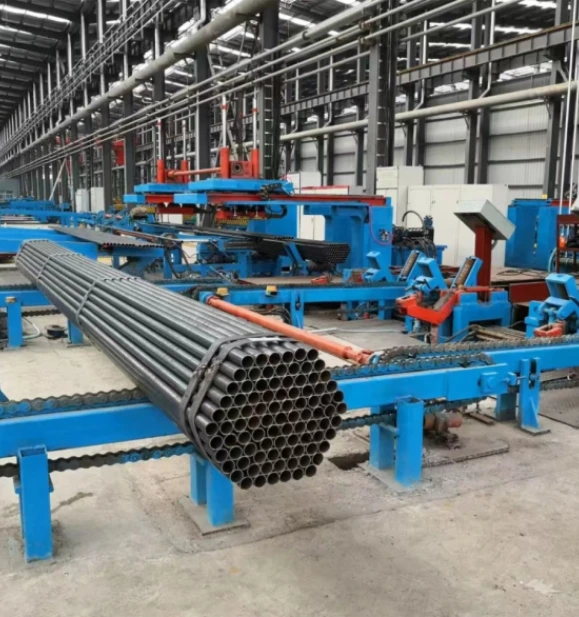Innovative Solutions for Roll Forming Applications in Modern Manufacturing Processes
Understanding Roll Forming Products
Roll forming is a highly efficient manufacturing process used to create long lengths of metal products with consistent cross-sections. This technique is widely employed in various industries, including construction, automotive, and furniture manufacturing. By using a series of rollers, raw metal strips are gradually bent into desired shapes, enabling the production of complex profiles that are integral to modern design and functionality. In this article, we will explore the fundamentals of roll forming products, their advantages, applications, and the technology behind the process.
What is Roll Forming?
Roll forming involves passing a metal sheet or strip through a series of rollers that gradually shape the material into a specific profile. The process typically begins with a flat strip of metal that is fed into a set of rollers, each designed to perform a specific bending operation. By the time the material exits the last roller, it has been transformed into a finished product with the desired geometry.
The roll forming process is particularly favorable for producing parts in large quantities and with precision, making it an excellent choice for manufacturers who require uniformity across products. Materials commonly used in roll forming include steel, aluminum, and other metals, which can be coated or treated to enhance their properties.
Advantages of Roll Forming
There are several advantages to using roll forming for manufacturing products
1. Cost-Effectiveness Roll forming is ideal for mass production. Once the initial tooling is created, the cost per unit significantly decreases, making it cost-effective for high-volume production runs.
2. Material Efficiency The process generates minimal waste compared to other forming methods, as it utilizes the entire width of the metal strip, producing only the desired profile.
4. Versatility Roll forming can be used to create a wide variety of shapes, including complex profiles like angles, channels, tracks, and custom designs, enabling manufacturers to meet diverse customer needs.
roll forming products

5. Consistency and Precision The roll forming process ensures high precision and uniformity across large production runs, maintaining tight tolerances throughout the manufacturing process.
Applications of Roll Forming Products
Roll forming is utilized in numerous industries to produce a wide range of products. Some common applications include
- Construction Roll-formed products such as metal studs, purlins, and roofing panels are widely used in commercial and residential construction. Their strength and lightweight nature make them a popular choice for structural components.
- Automotive In the automotive industry, roll formation is used to create lightweight chassis components, brackets, and trim parts. These components are essential for reducing vehicle weight while maintaining structural integrity.
- Furniture Roll forming is also employed in producing high-strength furniture components, such as frames and supports, which require both durability and aesthetic appeal.
- Electrical Roll-formed products such as channels and enclosures are used in electrical installations, providing protection and support for wiring and components.
The Technology Behind Roll Forming
Modern roll forming operations utilize advanced technology, including computerized control systems and automated machinery, to enhance efficiency and precision. The design of the rollers and the sequence of forming steps are carefully engineered to ensure optimal performance. Additionally, many roll forming machines offer the ability to perform secondary operations, such as punching and welding, further streamlining the manufacturing process.
In conclusion, roll forming is a vital technique in manufacturing that delivers high-quality, cost-effective, and versatile products. Its ability to produce complex shapes with precision makes it indispensable in many industries. As technology continues to evolve, the roll forming process will likely become even more efficient, paving the way for innovative applications and continued growth in various sectors.
-
High Frequency Straight Seam Welded Pipe Production Line-BzZhou Xinghua Machinery Equipment Manufacturing Co., LTD.|Precision Welding, High EfficiencyNewsJul.30,2025
-
High Frequency Straight Seam Welded Pipe Production Line|BzZhou Xinghua|Precision Welding&EfficiencyNewsJul.30,2025
-
High Frequency Straight Seam Welded Pipe Production Line - BzZhou Xinghua|Precision Engineering&EfficiencyNewsJul.30,2025
-
High-Frequency Straight Seam Welded Pipe Production Line-BzZhou Xinghua Machinery Equipment Manufacturing Co., LTD.NewsJul.30,2025
-
High-Frequency Straight Seam Welded Pipe Production Line-BzZhou Xinghua Machinery Equipment Manufacturing Co., LTD.|Precision Manufacturing, High EfficiencyNewsJul.30,2025
-
High Frequency Straight Seam Welded Pipe Production Line-BzZhou Xinghua Machinery Equipment Manufacturing Co., LTD.|Precision Steel Pipe Manufacturing&Industrial EfficiencyNewsJul.29,2025


